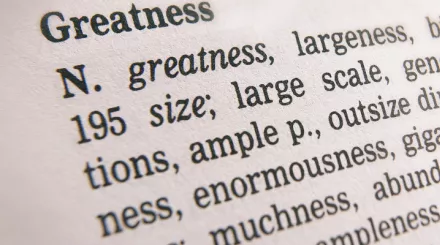This year’s theme of Speak Up North 2024 is belonging. If you’re thinking about submitting a short story for your Speak Up North entry, you may find this guidance as a good starting point to find inspiration, structure, and learn how to edit your work. There are no strict rules for the structure or length of a short story – but we’d recommend that your short story is no longer than 1000 words. Your work should also be related to the theme of belonging in some way.
Note that to exhibit your work, you should either type your short story or, if written by hand, use single pages of A4 and avoid writing on both sides of your paper. This is because the ink may bleed through the paper and make it more difficult to read.
What is a short story?
Traditionally, short stories were meant to be read in a single sitting —usually between 20 minutes to an hour. A short story is one of the most common forms of writing. It is often used to describe a single event, a single episode, or a tale of one particular character. The narrative style may either be first person or third, or whichever the author chooses. The setting of a short story is often simplified (one time and place), and one or two main characters may be introduced without full backstories.
Most short story authors create a distinct mood using classic literary devices (point of view, imagery, foreshadowing, metaphor, word choice, tone, and sentence structure).

What is belonging?
Where to start
1. Take the first line from an existing book or novel and use it to start a new piece of writing.
- “Before he even speaks, I know what he’s going to say.” - The Handover, David M. Barnet
- “There was no possibility of taking a walk that day.” – Jane Eyre, Charlotte Bronte
- “I found him in the garage on a Sunday afternoon.” – Skellig, David Almond
- “It was the small things she took pleasure in”. – The Letter, Kathryn Hughes
- “He couldn’t breathe”. – The Elephant Thief, Jane Kerr
- “We sat on the low cliff, Mam and I, overlooking the river mouth, and watched the smoke from our village over on the other side pluming into the sky and mixing with the clouds.” – The 1000-year-old boy, Ross Welford
2. Use an existing song title as the title and/or first line of your story and let it inspire you.
3. Stand somewhere where you feel like you belong. Close your eyes and listen. Write down any sounds or voices you hear. Write down the emotions you feel.

Merseyside

Greater Manchester

West Yorkshire
4. Use a picture or photo to inspire you. Look through your phone or at old photographs or use Google to search for images of places.
5. Start with an object. Describe it in vivid detail. Now explain who it belongs to.
Structure of a short story
Here are some examples of story structures to get you started. Feel free to use one or a mix of the suggested structures, or use a completely different one.
1. The classic
The plot will resemble a traditional narrative arc, with exposition (description) at the beginning, rising action, a climax (peak moment of conflict or action), and a resolution at the end.
2. Vignette
‘Vignette’ is a French word that usually refers to a small portrait, but it also refers to “a brief evocative description, account, or episode” in a literary sense. This might be a person, an event, or a location. It is usually heavy on description and short on plot.
3. Anecdote
When told to friends, an anecdote is most effective when it is fast-paced, funny, and has a swift crescendo. The same may be said of short stories that use this method to tell a story. Anecdotal pieces take on a more conversational tone and have a more meandering structure.
4. Fable
A tale that provides a moral lesson, often using animals, mythical creatures, forces of nature, or inanimate objects to come to life (Brothers Grimm, Aesop).
5. Magical realism
Combining realistic narrative or setting with elements of surrealism, dreams, or fantasy (Gabriel García Márquez).
6. Genre experimenting
Short stories, by their very nature, are more adaptable pieces of fiction that aren’t bound by the constraints of lengthier pieces.

Vocabulary and phrases
1. Use a thesaurus to find synonyms for what you’re writing about
- Synonyms for ‘belong’: match, permeate, associate, fit, become, harmonise, apply, exist, reside
- Synonyms for ‘belonging’: acceptance, association, inclusion, loyalty, affinity, kinship, acceptance
- Phrases that mean ‘to belong’: be connected with, be part of, be linked to
2. Use paragraph starters
Some examples of set phrases to start your paragraph, relating to belonging, could be:
- I remember...
- I want to tell you / I don't want to tell you...
- They say...
- Here's to...
- I come from...
- I am writing from a place that...
- There was a time when...
- Belonging is...
- Home is...

3. Seek inspiration from writing, books, and novels that you like
What makes a good short story
“Short stories are tiny windows into other worlds and other minds and other dreams. They are journeys you can make to the far side of the universe and still be back in time for dinner.” ― Neil Gaiman
We at Tutor Trust are looking for three main things in your finished piece of writing:
- The ability to tell a compelling story, convey an idea, and/or create a feeling or mood
- Creativity
- Use of language (including imagery)
“Details make stories human, and the more human a story can be, the better.” — Ernest Hemingway
Editing your short story
The best writers review their work with a fresh pair of eyes after finishing a first draft. There are a few things you can do in the editing stage to make your story even better than it already is.
Read for content and ideas
The main aim of a poem is to convey a clear idea. Read over your poem, from a reader’s viewpoint, to ensure that what you are saying makes sense.
Edit scene-by-scene
Having a sharper focus on individual sections of your story will help you spot what you’re doing well and where you may change a few things.
Check for spelling, grammar, and punctuation (SPaG)
You may want to use a dictionary or a digital spell checker to check for spelling, grammar, and punctuation. You may also want to ask your class teacher or your parent, carer, or guardian to check it as well.
Review your vocabulary
You may want to use a thesaurus to make your verbs stronger and consider synonyms.
If you come across any cliché phrases (these are phrases that are overused), think about replacing them with something more unique. You may do this by looking for an alternative phrase or adding a more specific description, which will make your work more original.
Often, removing quantifiers such as ‘really’ and ‘very’ makes your writing more concise and to the point.
Read your poem out loud
This will ensure that the story you’re telling is clear, the language you use is effective, and if you’re using a set rhyming and meter, that it sounds like you imagined it too.
More story-writing resources
You can also find out more about Speak Up North, including guest judges, prizes, and more!

